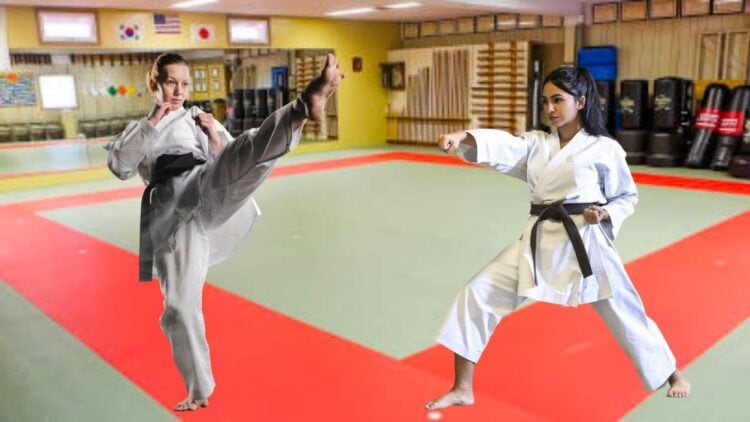
OBJECTIVE OF KARATE: Score more points than the opponent by landing technical kicks and punches.
NUMBER OF PLAYERS: 2 players
MATERIALS: Uniform, belt, chest armor, headgear, gloves, sparring shoes
TYPE OF GAME: Sport
AUDIENCE: 3+
OVERVIEW OF KARATE
The sport Karate is a martial art focused on defensive maneuvers and counterattacks. Similar to most other martial art combat sports, karate is as much about physical improvement as it mental and moral development.
Many people believe karate rules originated in Japan. While this is somewhat true because of the location it originated from, it is not quite that simple. In reality, karate’s earliest form evolved from Chinese Kung-Fu during the 14th century, with the earliest name for karate actually translating to “Chinese hand”. However, karate’s evolution was most prevalent in Okinawa—a present-day major Japanese island that was owned by the Chinese Ryukyu kingdom at the time.
With the Japanese annexation of the Ryukyu kingdom in 1879, many Okinawans migrated to the Japanese mainland, taking karate with them. It wasn’t until 1935, due to the rise of Japanese imperialism leading up to World War II, that the Japanese changed the name to mean “empty hand”, to symbolize the sport’s use of only the body as a weapon.
Karate’s modern popularity, especially in the United States, can be attributed to the heavy American military presence on Okinawa since World War II’s conclusion. It was here that the native Okinawans introduced stationed American soldiers to the martial art, with many of them bringing the sport back to the US. Due to this, karate exploded in popularity in the United States thanks to many popular martial arts movies made during the 60s, 70s, and 80s, such as the original Karate Kid. Following this popularity in 1992 the World Karate Federation was founded.
For the modern day, karate is still a widely popular martial arts discipline all over the world. In fact, some could argue its popularity is still growing to this day, as karate was featured in the 2020 Tokyo Summer Olympic Games for the first time in history!
SETUP

EQUIPMENT
- Uniform: Also known as a “gi”, a karate uniform is generally a plain white robe-like outfit.
- Belt: Perhaps the most iconic part of karate, a colored sash-like belt tied around an athlete’s waist signifies their rank and prestige in the sport.
- Chest Armor: Padding worn underneath the uniform to help protect the upper body from punches and kicks.
- Headgear: Padded helmets that protect the head against contact.
- Gloves: Padded gloves that are slightly smaller than gloves used in most other martial arts sports.
- Sparring Shoes: While many individuals go barefoot, sparring shoes are optional to protect against foot injuries when performing powerful kicks.
BELT COLORS
Belt colors signify the rank and prestige of a karate athlete. The newest karate recruits begin with a plain white belt, while the most advanced karate masters are given a black belt. The following is a list of belts in order from least prestigious to most prestigious:
- White
- Yellow
- Orange
- Green
- Blue
- Purple
- Red
- Brown
- Black
However, once a karate student reaches the black belt, the progression is not over. There are ten different tier levels, called dan, that separate black belt karate masters.
- 1st dan:The first level of blackbelt. This usually takes 3.5 to 5 years of dedicated training.
- 2nd dan: The next level is for black belts who have further mastered the fundamentals of the martial art. It may take another 2 years of dedicated training to reach this level.
- 3rd dan: This is for karate pupils who are very skilled. It may take another 2 years after reaching 2nd dan to get to this level.
- 4th dan: Karate pupils have mastered practical applications of the martial art. Typically can be achieved 3 years of intensive training after reaching the 3rd dan.
- 5th dan: VERY skilled master martial artists at this level who have mastered many elements of karate. Usually takes 5 years to reach this level after becoming a 4th dan black belt.
- 6th dan: Considered a master of karate at this level. Requires another 6 years of intensive training to reach this tier.
- 7th dan: This master karate status takes another 7 years of training to achieve.
- 8th and 9th dan: At these levels, you are considered a grand master and lifelong disciple of karate. Pupils who reach this level are typically in their 60s.
- 10th dan: This level is generally reserved for the founder or leader of a karate style.
KARATE DISCIPLINES
There are two main disciplines of competition karate:
- Kata: Essentially a “dance” routine of sorts, kata (which translates to “form”) is a non-combat routine performed by a single individual or team. During these routines, the competitor(s) performs various offensive and defensive karate maneuvers that somewhat resemble them sparring with an imaginary opponent. Excellent form and execution are key in kata.
- Kumite: The form of karate that most people are familiar with, karate kumite pits two fighters against each other in a combat match. While these matches are about delivering powerful kicks and punches to the opponent, the primary objective is to do so with excellent technique—not with force meant to injure the opponent.
For the sake of simplicity, the focus of this article will be primarily on the combat sport of kumite, not kata.
GAMEPLAY

Karate matches take place on a matted square pad measuring roughly 26 feet by 26 feet. At the start of a match, both competitors bow to each other before the referee yells the “go” command.
For the next three minutes, the two competitors square up and attempt to land kicks and punches to various parts of their opponent’s body to earn points. In the event that one competitor amasses an eight-point lead on their opponent, the match automatically ends; otherwise, the match continues until the referee stops the fight after the allotted time runs out.
SCORING
Scoring in karate is somewhat similar to taekwondo—kicks are worth more points than punches, while head contact is generally worth more points than body contact. Each method of scoring has a specific name:
- Yuko (A): Straight punch to the body (1 point)
- Yuko (B): Straight punch to the face (1 point)
- Wazari: Kick to the body (2 points)
- Ippon (A): Kick to the head (3 points)
- Ippon (B): Punch to the body when the opponent is on the ground (3 points)
As previously stated, contact in karate competitions is solely about technique and execution; purposefully violent or excessively forceful strikes can result in a penalty. Because of this, fighters are actually encouraged to try and make contact as light as possible while still being swift.
RULES
The following penalties are not allowed in karate:
- Excessive contact, especially that which causes bodily injury. Contact should be fully under control.
- Grabbing the opponent with both hands.
- Stepping out of bounds.
- Kicking the opponent below the torso.
Committing any of these penalties in a karate competition can either result in minor warning infractions that add up toward disqualification, outright disqualification from a match, and, in the most extreme of cases, disqualification from the entire tournament.
END OF GAME
The fighter who gains an eight-point advantage on their opponent or has the most points by the time the clock runs out wins the karate match.
In the event of a tie at the conclusion of the three-minute match, the referees decide who won the match; there is no golden point rule or overtime period.
- 30 GAMES TO PLAY OVER TEXT - April 22, 2024
- 20+ FREE PRINTABLE BABY SHOWER GAMES - April 16, 2024
- 20+ College Party Games for the Best Night Ever! - April 2, 2024